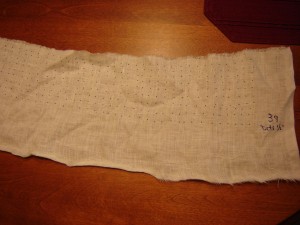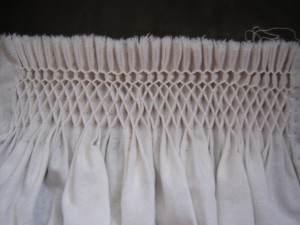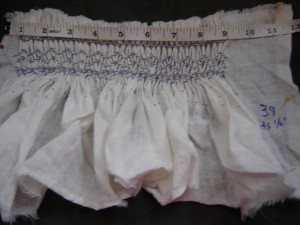Smocking was something I saw for the first time at Kindgom A&S 2011. When Mistress Adela’s elevation was announced the same day, the idea was planted to try my hand at a smocked apron for her. I work well with motivating deadlines, so Fall Coronation, gave me not only a reason to give it a try but plenty of time to get my act together.
 Pleating was the first step. I don’t have access to a pleater so I started with a meter stick and a sharpy. Reading I had done suggested half an inch pleating dots and that shrinkage is generally 1:5 to 1:7 depending on fabric type. I was using pretty thin scrap linen. This is my first attempt, starting with 39in of pleated fabric. I ran embroidery thread through each row and gathered. From there I embrodiered across the pleats. I started smocking using a pattern book I found at the public library, 155 Smocking Designs by Theresa Santoso. There was a nice section on geometric designs and very detailed instructions. Using Santoso’s directions I embrodered across the pleats using 2 strands of embroidery thread and took bites of roughly a quarter of fabric fold for each pleat.
Pleating was the first step. I don’t have access to a pleater so I started with a meter stick and a sharpy. Reading I had done suggested half an inch pleating dots and that shrinkage is generally 1:5 to 1:7 depending on fabric type. I was using pretty thin scrap linen. This is my first attempt, starting with 39in of pleated fabric. I ran embroidery thread through each row and gathered. From there I embrodiered across the pleats. I started smocking using a pattern book I found at the public library, 155 Smocking Designs by Theresa Santoso. There was a nice section on geometric designs and very detailed instructions. Using Santoso’s directions I embrodered across the pleats using 2 strands of embroidery thread and took bites of roughly a quarter of fabric fold for each pleat.
My first sample came out better than I hoped and roughly 9 inches wide. I was hoping for a foot wide when finished as this is roughly hip point to hip point on myself. I haven’t yet been able to find clear documentation for smocking in the 14th-16th century’s but had found several examples of aprons (images and links to come). The majority of these images show a the apron width at the waist to be what I image to hip point to hip point, so at least I had a goal. Since I wasn’t able to find documentation for smocking in general, I didn’t want to get to fancy with the design. However, I figure if there was pleating and there was embroidery, heavily designed smocking doesn’t sound unreasonable. As an apron is typically more of a working garment, it also figures there might not be that much effort put into embellishiment. Regardless, I had decided I was making a fancy apron and thats what I was going to do.
I decided on white thread for a more subtle effect. Pennsic provided the opportunity to pick up some mid-weight white linen that had the kind of drape I inititally had in mind. The final sample was done using this heavier linen and white thread. I also simplified the design. Pleating 52inches of fabric yeilded 13inches of smocked pleats. This time I had used a pencil to mark the pleating dots with the hope that graphite would be less noticable and wear away over time.
the pleating dots with the hope that graphite would be less noticable and wear away over time.
I repeated this exact pattern for the final apron. I rolled and bound the edges of the apron using a running stich. Taking a 2.5inch strip off the bottom of the apron I folded it over the top edge of the pleats to form a 1inch waist band. Of coarse, the majority of the waistband sewing was done in the car on the way to Coronation.
So now I have written up my first post and my mean Laurel can stop hounding me about it. If anyone happens to be reading it, any suggestions for documenting resources or images would be much appreciated. I’m please with the finally product and happy how it came out, but I have yet to find that it would actually have been done on an apron, or what kind of designs might have been typically used.

